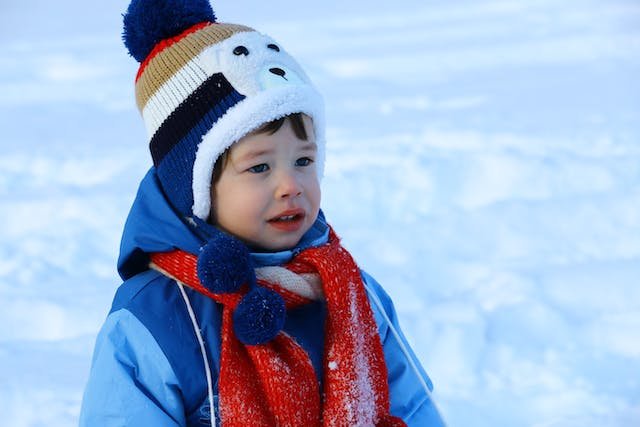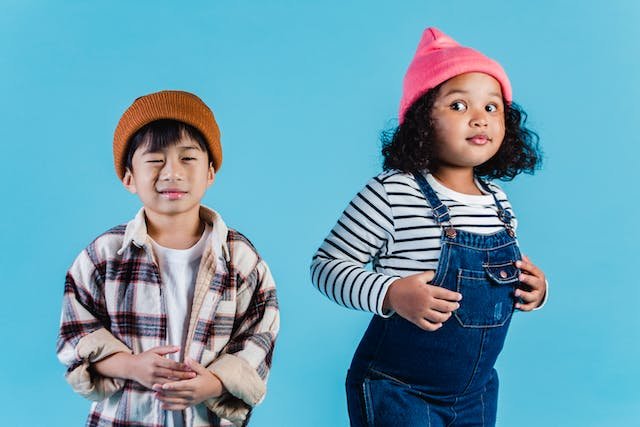Imagine a world where every child, regardless of their size or shape, could easily find stylish and sustainable clothing that makes them feel confident and comfortable. In today’s fashion industry, the importance of size-inclusive eco-fashion for kids cannot be overstated. This article explores the significance of offering a diverse range of eco-friendly clothing options for children of all sizes, fostering positivity, and sustainability in the fashion landscape.

Challenges of Traditional Children’s Fashion
Traditional children’s fashion often falls short in providing clothing options that cater to the diverse sizes and shapes of kids. This creates a significant challenge for many children who struggle to find stylish and sustainable clothing that makes them feel confident and comfortable. Additionally, the production and disposal of conventional kids’ clothing contribute to negative environmental impacts, further complicating the landscape of traditional children’s fashion.
Lack of Size Inclusivity in Kids’ Fashion
In the traditional realm of children’s fashion, there’s a significant drawback when it comes to catering to all shapes and sizes. Many kids and parents often struggle to find clothing that fits well and reflects their unique personalities. This lack of inclusivity can lead to a sense of exclusion and frustration, affecting children’s self-esteem and body confidence. Additionally, limited size ranges can perpetuate unhealthy beauty standards, reinforcing the notion that only certain body types are celebrated in the world of fashion.
It’s essential to address and rectify this issue by promoting an inclusive approach to kids’ fashion, where diversity in size is celebrated and embraced. This critical shift can help children feel more seen, valued, and confident in their skin.
Environmental Impact of Conventional Kids’ Clothing
Traditional kids’ clothing has a significant environmental impact, primarily due to the mass production of non-biodegradable materials such as polyester and nylon. These synthetic fabrics often end up in landfills, contributing to environmental pollution and taking hundreds of years to decompose. Additionally, the dyeing and finishing processes involved in manufacturing conventional kids’ clothing release harmful chemicals and toxins into the environment, further exacerbating the ecological footprint of the fashion industry. Overall, raising awareness about the environmental impact of conventional kids’ clothing is crucial in advocating for more sustainable and eco-friendly alternatives.
Benefits of Size-Inclusive Eco-Fashion
Picture this: eco-friendly clothing that not only makes kids look great but also makes them feel fantastic. Size-inclusive eco-fashion empowers children to feel confident and comfortable in their skin, regardless of their shape or size. By embracing diversity and sustainability in fashion, it sets the stage for positive self-esteem and a greener planet.
Boosting Children’s Confidence and Self-Esteem
When kids have clothing that fits well and makes them feel good, it can work wonders for their confidence and self-esteem. Imagine a child finding trendy, sustainable clothing that not only fits their body but also matches their unique style preferences. This kind of inclusive fashion fosters a positive self-image, allowing kids to express themselves authentically and embrace their individuality. When children feel good about what they’re wearing, it can boost their confidence and empower them to navigate the world with a positive attitude. It’s about creating a space where every child feels valued and beautiful just as they are.
Promoting Sustainable and Ethical Fashion Practices
When it comes to children’s fashion, promoting sustainable and ethical practices is crucial. By using eco-friendly materials and ethical production methods, we can reduce the environmental impact of clothing production. It’s important to support brands that prioritize fair labor practices and prioritize environmentally friendly production techniques. This not only sets a positive example for children but also contributes to a healthier and more sustainable fashion industry for the future.
Encouraging sustainable and ethical fashion practices in the children’s fashion landscape is a step towards a more responsible and conscientious industry. This approach not only benefits the environment but also educates kids about the importance of making mindful choices when it comes to clothing. By promoting sustainable and ethical fashion practices, we are nurturing a sense of responsibility and respect for the planet in the younger generation, shaping a more sustainable future.
How to Foster Size-Inclusive Eco-Fashion
When it comes to fostering size-inclusive eco-fashion for kids, collaboration and creativity play a pivotal role. By embracing diversity and utilizing sustainable practices, we can create a fashion landscape where children of all shapes and sizes feel valued and represented. Through innovative methods and conscious decision-making, we can pave the way for a fashion industry that celebrates inclusivity and sustainability.
Collaboration with KID Models of Diverse Shapes and Sizes
Collaborating with kid models of diverse shapes and sizes is vital for promoting and showcasing inclusivity in eco-fashion for children. By featuring a range of models with diverse body types, it sends a powerful message that every child is beautiful and worthy of representation in the fashion industry. This not only helps break stereotypes but also empowers children to feel confident and accepted, fostering a positive and inclusive fashion landscape for the future.
Utilizing Sustainable Fabrics and Production Practices
When it comes to eco-friendly kids’ fashion, the materials used in clothing production play a crucial role. Utilizing sustainable fabrics like organic cotton, hemp, and bamboo can significantly reduce the environmental impact of the fashion industry. By embracing production practices such as zero-waste pattern cutting, low-impact dyes, and ethical manufacturing, fashion brands can create clothing that not only benefits the planet but also ensures the well-being of the workers involved in the production process. Embracing these practices sets a positive example for the future of fashion and promotes a more sustainable and ethical approach to children’s clothing.
Importance of Education and Awareness
Imagine a world where children are empowered with the knowledge to make positive choices in fashion. By educating kids and parents about the impact of clothing choices and redefining beauty standards for kids, we can create a future where sustainability and inclusivity go hand in hand. It’s about instilling important values and fostering a mindset that celebrates diversity and promotes eco-friendly practices.
Empowering Children and Parents Through Education
Empowering children and parents through education about sustainable and size-inclusive fashion is crucial in reshaping their perspectives. By teaching children and parents about the environmental impact of clothing production and the importance of embracing diverse body shapes and sizes, we foster a generation of conscious consumers and advocates for inclusivity. Education instills values that go beyond fashion, empowering children and parents to make informed and ethical choices, leading to a more sustainable and accepting world.
Educating them about the positive impact of embracing diversity and sustainability helps create a more mindful and empathetic society. Through education, we can build a community that values authenticity and is committed to making a positive difference in the world.
Redefining Beauty Standards for Kids
Children’s fashion should be a reflection of diverse beauty, embracing all shapes and sizes. By redefining beauty standards for kids, the fashion industry can promote inclusivity and self-acceptance. It’s about encouraging children to feel confident and comfortable in their skin, regardless of societal norms. This shift in perspective can lead to a positive impact on children’s self-esteem and mental well-being. When kids see a range of body types and styles represented in fashion, they’re more likely to develop a healthy and accepting self-image. In this way, redefining beauty standards for kids contributes to building a more inclusive and empathetic society.
Supporting the Future of Fashion
When it comes to the future of fashion, supporting size inclusivity and eco-conscious practices for kids is crucial. By advocating for diversity within the fashion industry and encouraging the growth of sustainable kids’ fashion brands, we are taking significant steps towards a more positive and responsible fashion landscape. This support not only shapes the future of fashion but also instills essential values in the younger generation.
Advocating for Inclusivity in the Fashion Industry
When it comes to advocating for inclusivity in the fashion industry, it’s about challenging the norms and stereotypes that have been perpetuated for far too long. By vocalizing the need for diverse representations of all body types and sizes on the runway, in advertisements, and within fashion design, we can push for a more inclusive and accepting industry. This advocacy encourages brands and designers to recognize the beauty and individuality in every child, contributing to a more positive and uplifting fashion environment for kids worldwide. As the fashion industry continues to embrace and celebrate diversity, it sets a powerful precedent for inclusivity, inspiring positive change and empowerment for future generations.
“Inclusivity in fashion means celebrating diversity, acknowledging the beauty in all shapes and sizes, and paving the way for a more accepting and inclusive future in the fashion industry.”
Encouraging the Growth of Eco-Friendly Kids’ Fashion Brands
Nurturing the expansion of eco-friendly kids’ fashion brands is an essential step in revolutionizing the fashion industry. By backing and promoting these brands, we can stimulate a positive shift towards sustainability and inclusivity, ultimately ensuring that children of all shapes and sizes have access to stylish and eco-conscious clothing options. This support not only encourages the growth of innovative, environmentally conscious brands but also sends a powerful message to the fashion world, emphasizing the demand for diversity and sustainability in children’s fashion.
Conclusion
The concept of size-inclusive eco-fashion for kids goes beyond aesthetics and trends; it’s about embracing diversity, sustainability, and empowerment. By prioritizing inclusivity in children’s fashion and supporting environmentally conscious practices, we are not only shaping a brighter future for the fashion industry but also instilling important values in the hearts and minds of our younger generation..


